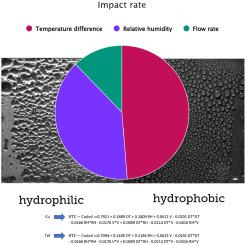Investigating the effect of environmental conditions and surface type on condensation heat transfer coefficient and droplet departure time
IF 4.9
2区 工程技术
Q1 ENGINEERING, MECHANICAL
International Journal of Thermal Sciences
Pub Date : 2024-10-05
DOI:10.1016/j.ijthermalsci.2024.109466
引用次数: 0
Abstract
This study investigates the impact of surface characteristics—hydrophilic (copper) and hydrophobic (Teflon-coated copper) surfaces—and environmental conditions such as relative humidity (RH) ranging from 80 % to 96 %, temperature differences (DT) from 4 °C to 10 °C, and airflow velocities (V) from 2 to 8 m/s during 180 min on humid air condensation heat transfer coefficient (HTC) and droplet departure time. The research utilizes a Design of Experiments (DOE) strategy, utilizing the Response Surface Methodology (RSM) paired with a Central Composite Design (CCD) to evaluate the influence of these parameters and provide a correlation relationship between the HTC of each surface and the applied environmental conditions. Hydrophilic surfaces generally exhibited higher average HTCs than hydrophobic ones. However, at a temperature difference of 10 °C, relative humidity of 96 %, and air velocities of 2 and 8 m/s, hydrophilic surfaces significantly decreased HTC due to a condensation regime transition from dropwise to filmwise. The highest recorded average HTC was 1.16 and 1.13 kW/m2°C on the hydrophobic surface under these conditions. The temperature difference had the most significant effect on increasing the HTC. Additionally, it was observed that the relative humidity played a more critical role than the flow velocity. There is a similar process for droplet exit, with the difference that in some experiments, the heat flux of hydrophobic surfaces was slightly higher than that of hydrophilic surfaces. Still, the drop fell on it later and left the surface because of the nature of the hydrophobic surface, which prevents droplets from spreading and coalescence with other droplets.

研究环境条件和表面类型对冷凝传热系数和水滴离开时间的影响
本研究调查了表面特性--亲水性(铜)和疏水性(特氟龙涂层铜)表面--以及环境条件(如相对湿度 (RH) 从 80 % 到 96 %,温差 (DT) 从 4 °C 到 10 °C,气流速度 (V) 从 2 m/s 到 8 m/s)在 180 分钟内对潮湿空气冷凝传热系数 (HTC) 和液滴离开时间的影响。研究采用了实验设计 (DOE) 策略,利用响应面方法 (RSM) 和中央复合设计 (CCD) 来评估这些参数的影响,并提供每种表面的 HTC 与应用环境条件之间的相关关系。亲水性表面的平均 HTC 值通常高于疏水性表面。然而,在温差为 10 °C、相对湿度为 96 %、气流速度分别为 2 米/秒和 8 米/秒的条件下,亲水性表面的 HTC 明显降低,这是因为冷凝机制从滴状过渡到了膜状。在这些条件下,疏水表面记录到的最高平均 HTC 分别为 1.16 和 1.13 kW/m2°C。温差对增加 HTC 的影响最大。此外,还观察到相对湿度比流速起着更关键的作用。液滴出口也有类似的过程,不同的是,在某些实验中,疏水表面的热通量略高于亲水表面。尽管如此,由于疏水表面的性质,液滴还是在其上落了一会儿就离开了表面,因为疏水表面阻止了液滴的扩散和与其他液滴的凝聚。
本文章由计算机程序翻译,如有差异,请以英文原文为准。
求助全文
约1分钟内获得全文
求助全文
来源期刊

International Journal of Thermal Sciences
工程技术-工程:机械
CiteScore
8.10
自引率
11.10%
发文量
531
审稿时长
55 days
期刊介绍:
The International Journal of Thermal Sciences is a journal devoted to the publication of fundamental studies on the physics of transfer processes in general, with an emphasis on thermal aspects and also applied research on various processes, energy systems and the environment. Articles are published in English and French, and are subject to peer review.
The fundamental subjects considered within the scope of the journal are:
* Heat and relevant mass transfer at all scales (nano, micro and macro) and in all types of material (heterogeneous, composites, biological,...) and fluid flow
* Forced, natural or mixed convection in reactive or non-reactive media
* Single or multi–phase fluid flow with or without phase change
* Near–and far–field radiative heat transfer
* Combined modes of heat transfer in complex systems (for example, plasmas, biological, geological,...)
* Multiscale modelling
The applied research topics include:
* Heat exchangers, heat pipes, cooling processes
* Transport phenomena taking place in industrial processes (chemical, food and agricultural, metallurgical, space and aeronautical, automobile industries)
* Nano–and micro–technology for energy, space, biosystems and devices
* Heat transport analysis in advanced systems
* Impact of energy–related processes on environment, and emerging energy systems
The study of thermophysical properties of materials and fluids, thermal measurement techniques, inverse methods, and the developments of experimental methods are within the scope of the International Journal of Thermal Sciences which also covers the modelling, and numerical methods applied to thermal transfer.
 求助内容:
求助内容: 应助结果提醒方式:
应助结果提醒方式:


